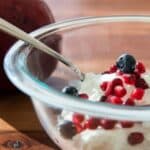Homemade Yogurt Recipe
Even if dairy is not entirely paleo, this 24h fermented, SCD compliant yogurt is not only a good source of probiotics, but also easy to prepare and cheap.
Servings 8 people
Calories 73kcal
Cost 20
Ingredients
- 4 cups whole milk or cream pastured, grass-fed or raw are the best choices
- Powder bacterial starter or ¼ cup good quality plain yogurt with live cultures
Instructions
- Sterilize yours tools beforehand by placing them in boiling water for at least ten minutes.
- Pour the milk in a heavy bottomed pan and let it heat at a medium low temperature making sure you stir often so it doesn’t scorch. The more fat in your milk, the less chance it will burn. You want to bring the milk to at least 180 F. Use either a thermometer making sure to stir before taking a measure or if you don’t have a thermometer look for small bubbles that form around the edges of the pan. This process kills off any other bacteria so the starter can have to whole place to play.4 cups whole milk or cream, Powder bacterial starter or ¼ cup good quality plain yogurt with live cultures
- Before introducing the starter, cool the milk to around room temperature. The fastest way to do that is to pour the heated milk in the glass jar/bottles that you’ll use for the fermentation and to put those jar/bottles in a cold water bath. You can then stir the milk to make the process happen even faster. If you put the starter in milk that’s too hot, you’ll kill it.
- If using a powdered starter, follow their instructions as for the quantity to use. I like to work in one bigger glass jar instead of smaller glass bottles because it’s simpler to clean afterwards. I find that the 4 cups glass measuring cups are ideal for both cooling the milk, mixing the starter and fermenting the yogurt. If you use multiple bottles, you might want to have the cooled milk in a jar to mix-in the starter so you can be more accurate about the quantity. If using leftover yogurt, prepare a paste of about ½ cup of the cooled milk with the ¼ cup leftover yogurt. Mix-in this paste to the rest of the cooled milk.
- Close up the bottles or cover the jar with plastic wrap and put it in an oven with the light on. The light acts as your heating element. This is where things can get a little bit touchy because the fermentation temperature is pretty important for the success of your yogurt. The temperature inside the oven should stay around 100 to 110 F and you can place a thermometer in the oven to know for sure. Most ovens will do just fine when simply keeping the light on. If it becomes too hot, you can open up the door just a tad. For those ovens that don’t become hot enough, you can buy a stronger light bulb, like a 60w, and use it when making yogurt. You can also heat the oven to the lowest temperature (usually around 170 F) and then turn it off and reheat it when the temperature has dropped enough.
- Let the milk ferment for about 24 hours. The lactose should be completely digested by 24 hours, but you can let the fermentation go for longer without problem.
- Place the jar or bottles in the refrigerator to cool and enjoy! You might sometimes end-up with a yogurt that is a bit more liquid than commercial yogurt, but often the taste won’t suffer. It all depends on the quantity and strength of the starter and temperature during the fermentation process. Most of the time though, it should come out just fine. Be aware though that once you take the fermented yogurt out of the oven it will still be runny, bit it will solidify as it cools.
Nutrition
Calories: 73kcal | Carbohydrates: 6g | Protein: 4g | Fat: 4g | Saturated Fat: 2g | Polyunsaturated Fat: 0.1g | Monounsaturated Fat: 1g | Cholesterol: 15mg | Sodium: 46mg | Potassium: 183mg | Sugar: 6g | Vitamin A: 198IU | Calcium: 150mg
